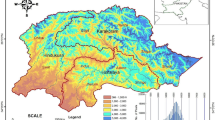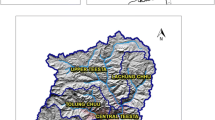Abstract
Glacial hazards relate to hazards associated with glaciers and glacial lakes in high mountain areas and their impacts downstream. The climatic change/variability in recent decades has made considerable impacts on the glacier life cycle in the Himalayan region. As a result, many big glaciers melted, forming a large number of glacial lakes. Due to an increase in the rate at which ice and snow melted, the accumulation of water in these lakes started increasing. Sudden discharge of large volumes of water with debris from these lakes potentially causes glacial lake outburst floods (GLOFs) in valleys downstream. Outbursts from glacier lakes have repeatedly caused the loss of human lives as well as severe damage to local infrastructure. Monitoring of the glacial lakes and extent of GLOF impact along the downstream can be made quickly and precisely using remote sensing technique. A number of hydroelectric projects in India are being planned in the Himalayan regions. It has become necessary for the project planners and designers to account for the GLOF also along with the design flood for deciding the spillway capacity of projects. The present study deals with the estimation of GLOF for a river basin located in the Garwhal Himalaya, India. IRS LISSIII data of the years 2004, 2006 and 2008 have been used for glacial lake mapping, and a total of 91 lakes have been found in the year 2008, and out of these, 45 lakes are having area more than 0.01 km2. All the lakes have been investigated for vulnerability for potential bursting, and it was found that no lake is vulnerable from GLOF point of view. The area of biggest lake is 0.193, 0.199 and 0.203 km2 in the years 2004, 2006 and 2008, respectively. Although no lake is potentially hazardous, GLOF study has been carried out for the biggest lake using MIKE 11 software. A flood of 100-year return period has been considered in addition to GLOF. The flood peak at catchment outlet comes out to be 993.74, 1,184.0 and 1,295.58 cumec due to GLOF; 3,274.74, 3,465.0 and 3,576.58 cumec due to GLOF; and 100-year return flood together considering breach width of 40, 60 and 80 m, respectively.





Similar content being viewed by others
References
Ageta Y, Iwata S, Yabuki H, Naito N, Sakai A, Narama C, Karma T (2000) Expansion of glacier lakes in recent decades in the Bhutan Himalayas. In: Debris-covered glaciers, proceedings of a workshop held in Seattle, Washington, USA, Sept 2000. International Association of Hydrological Sciences, Wallingford, pp 165–175
Benn D, Wiseman S, Warren C (2000) Rapid growth of a supraglacial lake, Ngozumpa Glacier, Khumbu Himal, Nepal. Debris-covered glaciers. IAHS 264:177–186
Bolch T, Buchroithner MF, Peters J, Baessler M, Bajracharya S (2008) Identification of glacier motion and potentially dangerous glacial lakes in the Mt. Everest region, Nepal using spaceborne imagery. Nat Hazards Earth Syst Sci 8:1329–1340
Campbell JG (2005) Inventory of glaciers, glacial lakes and the identification of potential glacial lake outburst floods (GLOFs) affected by global warming in the mountains of India, Pakistan and China/Tibet Autonomous Region, Technical Report of APN Project 2004-CMY-Campbell, available online at http://ns.apn.gr.jp/en/products/project_reports/2004/Final%20Report/2004_03_CMY_Campbell.pdf
Frey H, Haeberli W, Linsbauer A, Huggel C, Paul F (2010) A multi-level strategy for anticipating future glacier lake formation and associated hazard potentials. Nat Hazards Earth Syst Sci 10:339–352
Hardy CC, Burgan RE (1999) Evaluation of NDVI for monitoring moisture in three vegetation types of the western U.S. Photogramm Eng Remote Sens 65:603–610
Huggel C (1998) Periglaziale Seen im Luft- und Satellitenbild. Diploma Thesis, Department of Geography, University of Zurich
Huggel C, Kääb A, Haeberli W, Teysseire P, Paul F (2002) Remote sensing based assessment of hazards from glacier lake outbursts: a case study in the Swiss Alps. Can Geotech J 39:316–330
ICIMOD (2010) Formation of glacial lakes in the Hindu Kush-Himalayas and GLOF risk assessment. In: Ives JD, Shrestha RB, Mool PK (eds) International Centre for Integrated Mountain Development, Kathmandu, May 2010
Kumar R, Singh RD, Sharma KD (2005) Water resources of India. Curr Sci 89:774–811
Lichtenegger J, Gurung DR, Mool PK, Bigot J (2008) Near real-time monitoring of glacial lake Imja (Khumbu-Everest region). In: Proceeding of the ESA living planet symposium, Bergen, Norway, 28 June to 10 July
Molnia BF (2009) Inventorying and monitoring the recent behavior of Afghanistan’s glaciers, debris-covered glaciers, supraglacial lakes, and the potential for catastrophic flooding (jökulhlaups). In: European Geosciences Union General Assembly 2009, Geophysical Research Abstracts, vol 11, EGU2009-13939, Vienna, Austria, 19–24 Apr 2009
Mool PK (2005) Monitoring of glaciers and glacial lakes from 1970 s to 2000 in Poiqu Basin, Tibet Autonomous Region, PR China. Unpublished report prepared by ICIMOD, Kathmandu, Nepal, and CAREERI, Gansu, China
Quincey DJ, Richardson SD et al (2007) Early recognition of glacial lake hazards in the Himalaya using remote sensing datasets. Glob Planet Change 56(1–2):137–152
Raj KBG (2010) Remote sensing based hazard assessment of glacial lakes: a case study in Zanskar basin, Jammu & Kashmir, India. Geomat Nat Hazards Risk 1(4):339–347
Reynolds JM (2000) On the formation of supraglacial lakes on debris-covered glaciers. IAHS Publ 264:153–161
Sakai A, Chikita K, Yamada T (2000) Expansion of a moraine-dammed glacial lake, Tsho Rolpa, in Rolwaling Himal, Nepal Himalaya. Limnol Oceanogr 45(6):1401–1408
Sharma D, Singh B, Perumal M, Rai NN (2009) Study of glacial lake outburst flood for punatsangchhu hydro electric project, Bhutan, presented in national symposium on climate change and water resources in India, 18–19 Nov 2009 organised by IAH, Roorkee at NIH, Roorkee
Thompson S, Benn D, Luckman A, Kulessa B (2010) The evolution of supraglacial lakes, Ngozumpa Glacier, Khumbu Himalaya, Nepal. Geophysical Research Abstracts, vol 12, EGU2010-11396-1
Ukita J, Narama C, Tadono T, Yamanokuchi T, Tomiyama N, Kawamoto S, Abe C, Uda T, Yabuki H, Fujita K, Nishimura K (2011) Glacial lake inventory of Bhutan using ALOS data: part 1, methods and preliminary results. Ann Glaciol 52(58):2011
Watanabe T, Ives JD, Hammond JE (1994) Rapid growth of a glacial lake in Khumbu Himal, Nepal: prospects for a catastrophic flood. Mt Res Dev 14:329–340
Yao T et al (2010) Glacial distribution and mass balance in the Yarlung Zangbo River and its influence on lakes. Chin Sci Bull 55(20):2072–2078
Author information
Authors and Affiliations
Corresponding author
Rights and permissions
About this article
Cite this article
Jain, S.K., Lohani, A.K., Singh, R.D. et al. Glacial lakes and glacial lake outburst flood in a Himalayan basin using remote sensing and GIS. Nat Hazards 62, 887–899 (2012). https://doi.org/10.1007/s11069-012-0120-x
Received:
Accepted:
Published:
Issue Date:
DOI: https://doi.org/10.1007/s11069-012-0120-x




